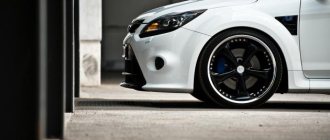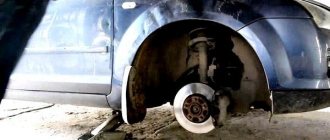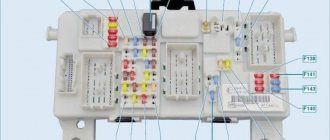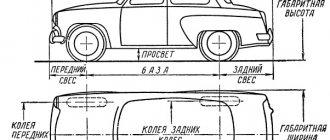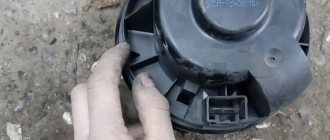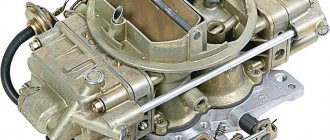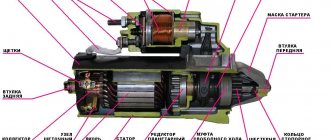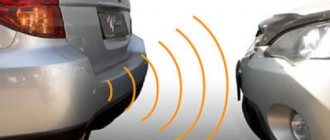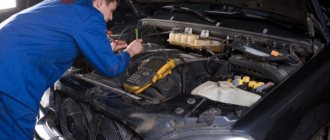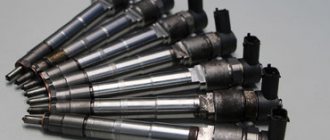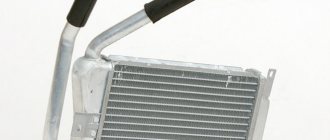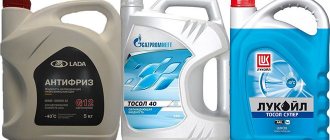The rear suspension installed on the second generation Ford Focus has a multi-link design, which ensures a smooth ride and confident behavior of the car on the road. But the multi-link system has not only advantages, but also its disadvantages - in case of mechanical damage, you have to change more parts, and the repair of the chassis itself is not cheap. In this article we will look at what the rear suspension of a Ford Focus 2 is: diagram, repair, what are the characteristic “diseases” of the chassis, how to replace the rear shock absorber and stabilizer bar.
Rear suspension diagram for Ford Focus 2
The rear suspension of the Ford Focus-2 is an independent type, with a cross member in the middle, with four levers at each rear wheel (a total of 8 levers). The chassis consists of the following elements:
- crossbars;
- levers – rear lower, upper, front lower, longitudinal;
- springs;
- shock absorbers;
- compression buffers.
All elements, except the transverse beam, are paired; a stabilizer bar with struts and bushings is also installed on the rear axle.
The Ford Focus-2 was produced in two body modifications - a pre-restyling version (2005-2008) and a restyled version (2008-2011). After the modernization, some changes took place in the car, but the rear suspension was not affected by restyling - it remained the same.
The rear suspension is independent, multi-link, with coil springs and double-acting hydraulic shock absorbers. The main load-bearing elements of the suspension are stamped trailing arms, each of which is connected to the subframe by three transverse arms through silent blocks. Braking forces when the car is moving are perceived by the longitudinal arms, and forces in the direction perpendicular to the longitudinal axis of the car are perceived by the transverse arms of the suspension.
Trailing arm
A silent block is installed in the front part of the trailing arm, through which the arm is secured with two bolts to the body. The rear wheel hub assembly is secured to the rear of the lever with four screws.
Rear wheel hub assembly: 1 — rear wheel hub; 2 - wheel speed sensor
The hub assembly is a non-separable unit with a bearing and a driving element for the wheel speed sensor of the anti-lock brake system.
Lower rear arm
The lower rear arms have spring support cups. The upper ends of the springs rest against the subframe cups. The cups have rubber gaskets. The lower shock mount is bolted to the trailing arm, and the upper shock mount is bolted to the body. Shock absorbers and springs in the rear suspension allow the rear wheels to move up and down when driving over bumps and at the same time dampen body vibrations.
Parts of the anti-roll bar: 1 - lower cushion with bolt; 2 - buffer; 3 — top pillow; 4 - nut with washer; 5 — rod; 6 - pillow; 7 - bracket
To increase lateral stability and reduce vehicle roll angles, a stabilizer bar is installed. The stabilizer bar in its middle part is attached with two brackets through rubber split pads to the subframe. The ends of the stabilizer bar are connected to the rear lower arms through struts with rubber-metal hinges.
Upper arm
Lower front arm
The toe angles of the rear wheels are adjusted by rotating the bolts securing the lower rear arms to the subframe (adjusting bolts).
The adjusting bolt has an eccentric head and a washer. When the bolt and washer rotate, its position in the hole in the subframe changes: when the bolt moves towards the longitudinal axis of the car, the reach of the lower rear arm decreases and, consequently, the toe angle of the wheel decreases; When the bolt moves from the axis, the angle increases.
Ford Focus 2 rear suspension repair
In the domestic market, the overwhelming majority of Ford Focus-2s are only Russian-assembled, so it is difficult to talk about the quality of spare parts installed on cars assembled in Spain and Germany. But cars assembled in Vsevolozhsk near St. Petersburg are distinguished by fairly high reliability, and the rear suspension lasts a long time during normal use.
If the car is not driven at high speed on bad roads, the chassis will require more or less serious repairs after a mileage of about 100 thousand km, not earlier. As a rule, the trailing arms are the first to fail; the silent blocks in them wear out. You don’t have to completely change the lever, you can get by by repressing the silent blocks, but in order to make such a repair, it is necessary to disassemble almost the entire suspension.
The rear shock absorbers on the Second Focus are distinguished by enviable “survivability”; on average, the parts last from 90 to 130 thousand km. The price of original spare parts is rather high; each shock absorber costs about 3.5 thousand rubles. But fortunately, Focus-2 has parts of non-original production, and of very decent quality. For example, Monroe or Kayaba shock absorbers can be purchased at a price of 2-2.5 thousand rubles. for 1 piece, and spare parts from TRW are even cheaper. Many other companies also produce these parts:
- Bilstein;
- SACHS;
- Koni et al.
Stabilizer struts are usually the first to fail on many car models, but on the Ford Focus 2 these parts are surprisingly durable, sometimes lasting more than 100 thousand km.
Second Focus car owners need to know that many spare parts for the car are suitable from the Mazda 3, in particular, many rear suspension parts are almost identical. True, there is one difference here - original Ford spare parts are more reliable than Mazda ones, although they are more expensive.
Preliminary diagnosis of front suspension faults
Shock absorbers
- The function of a shock absorber is to dampen spring vibrations. If, when pressing on one side of the machine, it returns to its original position and there is no repeated vibration, the shock absorber is working.
- We grab the wheel and swing it towards and away from us. If we feel play, it means the shock absorber is faulty. If the play disappears after pressing the brake, there is a very high probability that it is time to change the front wheel bearing.
- Upon visual inspection, there should be no damage or oil leaks in the lower part of the shock absorber and the springs should be intact.
Steering rods
It's best to check when the car is raised.
We swing the wheel left and right. If play is felt, it means the ball joint, tie rod or tie rod is faulty.
Anti-roll bar joints
- No external damage to the ball strut covers.
- We move the stabilizer bar up and down by hand or using a pry bar. If we feel play, then the struts need to be changed.
Rear silent block for subframe mounting
- Visually there should be no delamination of rubber.
- We are trying to move the lever ear by inserting a screwdriver between it and the subframe. If it moves, then the silent block needs to be changed.
Ball joints
Take a screwdriver and carefully insert it between the lever and the steering knuckle. We move up and down. If there is play or knocking, the ball must be replaced.
Having completed the preliminary diagnostics, it is advisable to go to a service station and make sure your conclusions are correct. In most cases, the problem will be in the wheel bearing or one of the parts of the control arm.
Replacing rear shock absorber Ford Focus 2
If oil stains appear in the area of the rear shock absorber rod, and the car begins to drive over bumps with the rear part of the body swaying, the shock absorber has failed and needs to be replaced. We carry out the work as follows:
- for convenience, remove the rear wheel;
- We place a support under the rear suspension (for example, an old unnecessary wheel rim), and lower the car a little on the jack - you need to make sure that the suspension spring is compressed somewhat;
- this is done so that when the shock absorber is removed, the spring does not straighten without load and shoot upward;
- unscrew the bottom bolt that holds the shock absorber, for this you will need a wrench with a 15mm head;
- from the body (inside the wheel arch) unscrew the two bolts securing the shock absorber support to the body; here you will need a 10 mm socket wrench or a socket with an extension and a wrench;
- We dismantle the part to be replaced, install a new shock absorber in place, and carry out the assembly.
Let's start the renovation
First you need to drive the car onto a lift, pit or lift it on a lift. Next, you should install the coupler on the springs and compress them as much as possible. You won't be able to remove them, but there's no need to. Raise the main lever, which is mounted on the wheel, using a jack, and unscrew the bolt that secures the lever under the spring.
Broken suspension arm
Remove the springs and move the lever to the side so that it does not interfere with you in the future. Remove the two arms and the shock absorber at the lower mounting point. Disconnect the handbrake cable from the hook. Remove the bolt from the ABS sensor, the terminal and unscrew the two bolts that hold the rear suspension wishbone.
Move the wishbone to the side and you will have the opportunity to replace the lower and upper arms of the Ford Focus 2. At this stage, take your time so that nothing breaks. Next, replace the silent block, even if it is still intact. It is better to replace it now so that you do not have to disassemble the entire rear suspension in the future because of it. This element is dismantled under pressure using a special metal cylinder. You can buy this device in a store or turn it from a turner to the following dimensions:
- diameter 58 mm;
- height 70 mm;
- internal diameter 35 mm;
- depth 50 mm.
Next, insert the new silent block into place and remove the spring-loaded lever, and then replace it with a new one if necessary. The rear suspension of the Ford Focus 2 is assembled independently in the reverse order. Thus, by spending a little free time you can save a considerable amount of money on the work of professional craftsmen at a service station. Additionally, we recommend watching videos that will help you understand everything.
Replacing the rear stabilizer link
If a knock appears in the rear suspension area, it is likely that the stabilizer links are worn out. Changing parts is quite simple; if there are no complications during removal, you can replace the stabilizer strut in half an hour or even faster.
It is convenient to perform the replacement on a pit or a lift; the wheel does not need to be removed to perform the operation. We carry out the work in the following order:
- unscrew the nut that secures the strut to the wishbone of the suspension; for this you will need a 15 mm spanner. To prevent the strut from turning along the axis when unscrewing the nut, hold it with a hexagon;
- then use the same keys to unscrew the upper nut that holds the strut to the wishbone;
- Having unscrewed the fasteners, remove the old part, install the new one, and at this point we can consider the work completed.
Everything was simple, but the old stand does not always turn away normally. The thread on the ball pin becomes clogged with dirt, and when you try to unscrew the nut, the hex wrench turns in the body of the pin. Before you start unwinding the connection, you must:
- clean the threads on the stabilizer link from dirt;
- spray WD40 on it;
- wait 15-20 minutes for the remaining dirt to “eat off”.
Only after this should you begin to unscrew the nuts. If, nevertheless, the ball pin rotates in the body, and the nut rotates with it, you will have to use a small grinder to cut off the worn stabilizer link.
In this case, we consider replacing the L-shaped stabilizer struts, but the Ford Focus-2 can also install stabilizer struts of the so-called “straight” type.
These parts are even easier to change, and practically no complications arise here.
Tools for work
Self-repair of the rear chassis of a Ford Focus 2 will take a lot of time, but will not require any special knowledge and skills from you. If you've dealt with suspension repairs on any other car, you can probably handle this one too. To work, you will need a set of tools, including:
- jacks, pit or lift;
- hexagons;
- set of open-end wrenches and sockets;
- hammer;
- puller;
- spring ties;
- lubricant type VD-40;
- Litol;
- sometimes you need a grinder.
If you have all of the above, you can start replacing the Ford Focus 2 rear suspension kit yourself.
Replacing the rear suspension of a Ford Focus 2: video
Related articles:
- Replacing the arms and silent blocks of the front suspension of a Ford Focus 2 The car is deservedly popular - it is very reliable, the front suspension is also durable, the chassis parts almost always produce their […]
- Procedure for bleeding the clutch on a Ford Focus 2 Clutch failure is an unpleasant situation for many motorists; signs of such a malfunction are the inability to shift gears normally, and in many cases […]
- Replacing the wheel hub of a Ford Focus 2 Replacing the wheel bearing (HS) on a Ford Focus-2 is not very difficult; if you wish and have certain skills, you can do the work yourself. In this article we will look at how […]
